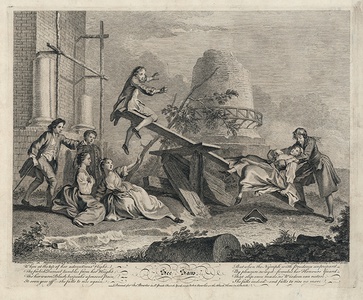| Method | Copper engraving |
| Artist | Louis Truchy after Francis Hayman |
| Published | Publish'd according to Act of Parliam't. Feby 1st. 1743/4. Printed for Thos. Bowles in St. Paul's Church Yard and John Bowles at the Black Horse in Cornhill. |
| Dimensions | Image 260 x 350 mm, Plate 290 x 365 mm, Sheet 370 x 435 mm |
| Notes |
A rare print depicting a group of people playing on a see-saw from a rare series of twelve scenes of pastimes and activities originally painted by Francis Hayman. One of twelve designs originally painted by Hayman to decorate the supper boxes at Vauxhall Gardens. The scene shows a man and a woman on a makeshift see-saw made from planks of wood. A small group of people look on as the man is tilted high, the woman on the other side falling backwards being caught by another man. Text below image: When at the top of her adventurous Flight, The frolick Damsel tumbles down from her Height, Tho' her warm Blush bespeaks a present Pain, It soon goes off - She falls to rise again. But when the Nymph with Prudence unprepar'd, By pleasure sway'd - forsakes her Honours Guard, That slip once made, no Wisdom can restore, She falls indeed! - and falls to rise no more. Louis Truchy (fl. 1740-1770) was a French artist and engraver. He is most known for his engravings of the Pamela paintings by the English artist Joseph Highmore, produced between 1741 and 1743 as the basis for a set of 12 prints. Francis Hayman (1708 - 1776) was a painter of history, portrait and genre. Born in Devon in 1708, he apprenticed to Robert Brown in 1718, producing scene paintings for Drury Lane Theatre. He went on to decorate supper boxes and pavilions at Vauxhall Gardens for Jonathan Tyers and he also contributed 31 pictures to a 1744 edition of Shakespeare's plays by Sir Thomas Hanmer, later portraying many leading contemporary actors in Shakespearean roles, including David Garrick as Richard III. Hayman taught at St. Martin's Lane Academy and was involved in the Society of Artists foundation in the 1760's, becoming President in 1766-68, and was also a foundation member of the Royal Academy. He exhibited at the SA 1760-68, and the RA 1769-72. John Bowles (c.1701-1779) was a British printmaker and publisher, and a member of the prolific and numerous Bowles family of printmakers. The second son of Thomas Bowles I, he established a publishing house in his own name following the passing of the family business to his older brother Thomas Bowles II after their father's death. In 1752, his son Carington joined the business, which traded under the name John Bowles & Son until 1764, when Carington took over the running of the original Bowles publishing house from his uncle, Thomas Bowles II. John Bowles specialised in mezzotint, especially portraits, though he also produced numerous topographical series and genre scenes. Condition: Professionally repaired hole and corner to lower margin. Professionally repaired hole to top margin. Surface marks to sheet. |
| Framing | unmounted |
| Price | £800.00 |
| Stock ID | 53328 |

